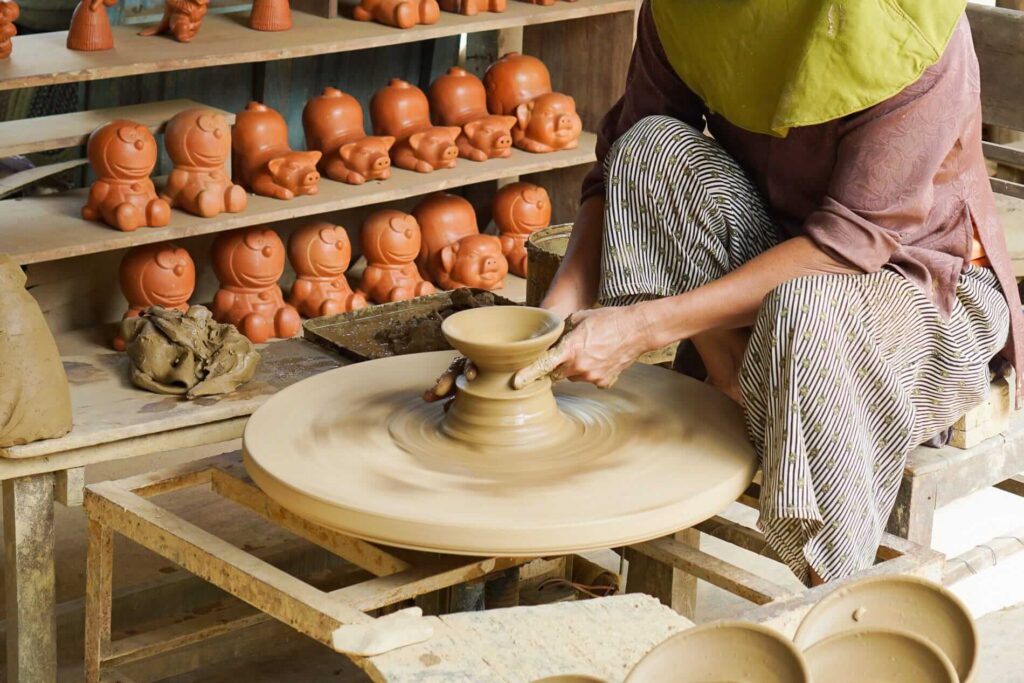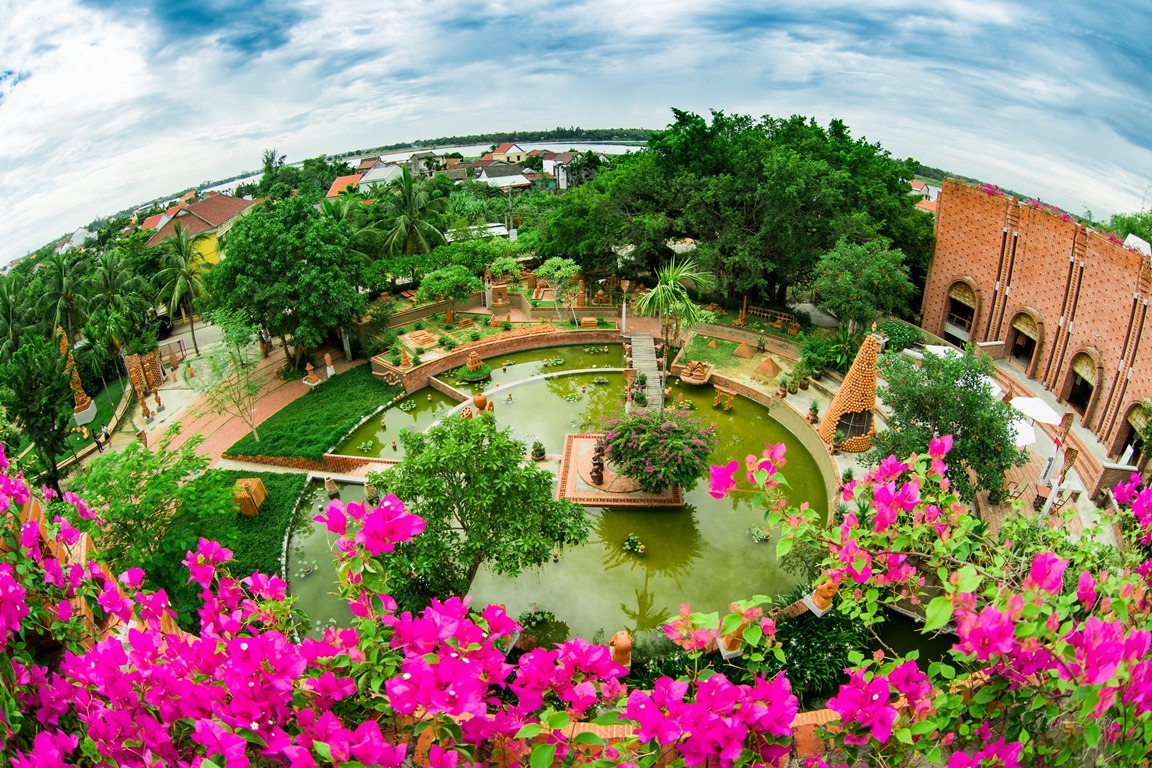Watch Artisans at Work in Thanh Ha Pottery Village
G’day, fellow travellers! Aussie Mates here, coming to you from the sunny shores of Vietnam where Tracy and I have called home for nearly two decades. Today I’m going to take you on a ripper of a journey to one of our favourite cultural spots in Hoi An – the magnificent Thanh Ha Pottery Village. If you’re looking to get your hands dirty (literally) and experience some authentic Vietnamese craftsmanship firsthand, this hidden gem is absolutely worth a burl.
After spending almost 20 years in Vietnam, Tracy and I reckon we’ve become pretty good at sniffing out those authentic cultural experiences that go beyond your standard tourist fare. This ancient pottery village, just a short jaunt from Hoi An’s Ancient Town, offers exactly that – a genuine glimpse into traditional Vietnamese craftsmanship that’s been preserved for over 500 years.
A Little History of Thanh Ha Pottery Village
Nestled along the peaceful banks of the Thu Bon River, Thanh Ha Pottery Village dates back to the late 15th century. The village was established during the reign of King Le Thanh Tong, when talented pottery artisans from northern Vietnam were brought south to develop the craft in the then-thriving trading port of Hoi An.
In its heyday, Thanh Ha’s pottery production was booming, supplying not only domestic needs but also trading with merchants from China, Japan, and various European countries. The village craftspeople created everything from everyday household items to elaborate decorative pieces and even roof tiles for many of the historic buildings you can still see standing in Hoi An’s Ancient Town.
Walking through the village today, it’s not hard to imagine how it might have looked centuries ago. While modern life has certainly made its mark, many traditional practices remain virtually unchanged. As Tracy commented during our last visit, “It’s like stepping into a living museum, but one where people are still going about their daily lives.”

Getting to Thanh Ha from Hoi An
Reaching Thanh Ha is a piece of cake, mates. The village sits about 3 kilometers west of Hoi An’s Ancient Town. You’ve got a few options to get there:
- Bicycle: Our personal favourite. It’s a cruisy 15-20 minute ride through beautiful countryside. Most hotels and guesthouses in Hoi An offer bicycle rentals for around 30,000-50,000 VND (roughly $2-3 AUD) per day.
- Motorbike: If you’re comfortable riding in Vietnam (not for the faint-hearted!), renting a scooter will get you there in about 10 minutes. Expect to pay around 100,000-150,000 VND ($6-9 AUD) for a daily rental.
- Taxi: For about 80,000-100,000 VND ($5-6 AUD) one way, this is the most comfortable but least adventurous option.
- Boat: For something special, you can arrange a boat trip along the Thu Bon River, which gives you a different perspective approaching the village from the water.
Tracy and I typically opt for bicycles – there’s nothing quite like the gentle pace, and you can stop anywhere along the way for photos or a quick break. The ride takes you through some gorgeous rural landscapes dotted with rice fields and water buffaloes. Pure magic!
What to Expect When You Visit
When you first arrive in Thanh Ha, you might be surprised by how unassuming it all seems. This isn’t some flashy tourist attraction with blinking lights and souvenir shops every two steps. It’s a real, functioning village where pottery has been the backbone of the community for generations.
You’ll need to purchase an entry ticket for around 35,000 VND ($2 AUD) per person, which includes access to the Thanh Ha Terracotta Park and various workshops. Keep this ticket handy as you’ll need to present it at different spots throughout the village.
As you wander the narrow lanes, you’ll notice numerous family workshops with their doors wide open, inviting visitors to come in and observe. The locals are incredibly welcoming – during our visits, Tracy and I have been beckoned into countless homes with warm smiles and enthusiastic demonstrations.
The Pottery-Making Process
What makes a visit to Thanh Ha so bloody special is the opportunity to observe (and try your hand at) the traditional pottery-making process from start to finish. Fair dinkum, it’s a ripper of an experience!
The process begins with clay collection. Traditionally, the artisans collected clay from the banks of the Thu Bon River, though these days some is sourced from other locations as well. This clay is then meticulously prepared – cleaned, mixed with water, and kneaded to achieve just the right consistency.
Next comes the shaping. This is where the magic happens, mates. Most of the artisans use traditional pottery wheels operated by foot or hand, not the electric wheels you might be familiar with. Watching these skilled craftspeople transform a lump of clay into a beautiful, symmetrical vessel in mere minutes is nothing short of mesmerizing.
I’ll never forget the time when Tracy tried her hand at the pottery wheel. The elderly artisan guiding her made it look effortless, but when Tracy took over… let’s just say her “bowl” looked more like something our dog might have left behind! We all had a good laugh, the artisan included, before he patiently helped her create something at least vaguely recognizable as tableware.
After shaping, the pieces are left to dry in the sun before being fired in traditional kilns. These brick kilns, some of which have been in use for decades, are heated with wood to temperatures of around 800-1000°C. The firing process can take anywhere from 8-12 hours, followed by a cooling period of several days.
Interactive Experiences – Get Your Hands Dirty!
One of the best parts about visiting Thanh Ha is that it’s not just a spectator sport. Many of the workshops offer hands-on experiences where you can try your luck at making your own pottery piece. For around 50,000-100,000 VND ($3-6 AUD), you can sit at a pottery wheel and receive one-on-one guidance from a master craftsperson.
Fair warning though – it’s harder than it looks! Both Tracy and I have tried numerous times over the years, and while we’ve improved slightly, our creations still tend to look a bit wonky. But that’s part of the fun, isn’t it?
If you do make something you’re proud of, some workshops will fire it for you, though you’d need to arrange to pick it up a few days later. Alternatively, you can paint already-fired pieces, which you can take home the same day.
Thanh Ha Terracotta Park
A newer addition to the village is the Thanh Ha Terracotta Park, an impressive museum and exhibition space showcasing pottery art in its highest form. The park features miniature replicas of famous landmarks from around the world – all crafted in terracotta – alongside contemporary pottery installations created by Vietnamese and international artists.
Tracy absolutely loves the miniature Sydney Opera House they’ve created – it’s become our tradition to snap a photo beside it on every visit. There’s something quite surreal about seeing familiar landmarks from home recreated in Vietnamese terracotta halfway across the world.
The park also houses a detailed exhibition on the history of Thanh Ha pottery, with information in English, Vietnamese, and several other languages. It’s well worth spending some time here to gain a deeper appreciation of the craft’s cultural significance.
What to Buy in Thanh Ha
If you’re like Tracy and can’t resist a good souvenir (our house back in Hoi An is practically a pottery museum at this point!), you’ll be spoilt for choice in Thanh Ha. The prices are significantly lower than what you’d pay in Hoi An’s tourist shops, and buying directly from the artisans means your money goes straight to the people who created your treasures.
Popular purchases include:
- Tea sets – beautifully crafted and practical
- Decorative vases and figurines
- Wind chimes and garden ornaments
- Miniature replicas of Vietnamese houses and temples
- Decorative tiles and pottery masks
Most items are remarkably affordable – small pieces start from around 50,000 VND ($3 AUD), while larger, more intricate items might set you back 300,000-500,000 VND ($18-30 AUD). Bargaining is expected but keep it respectful – these artisans work incredibly hard for relatively modest returns.
Best Time to Visit
Thanh Ha Pottery Village is open year-round, but timing your visit can enhance the experience. The village is typically active from early morning until late afternoon, roughly 7:00 AM to 5:00 PM daily.
If you’re keen to see the full range of activities, morning visits (8:00-10:00 AM) are ideal as you’ll catch many artisans starting their daily work – preparing clay, starting up the wheels, and beginning the creative process. The lighting at this time is also magnificent for photography.
Tracy and I have found that weekdays tend to be less crowded than weekends, providing more opportunities for one-on-one interactions with the artisans. If you visit during Vietnamese holidays, you might find some workshops closed or operating with reduced hours.
Where to Eat Nearby
While Thanh Ha doesn’t have many dedicated restaurants, there are several small local eateries (quán) along the main road where you can grab a bite. These typically serve simple Vietnamese fare like phở (noodle soup), cơm (rice dishes), and bánh mì (Vietnamese sandwiches).
On our visits, Tracy and I often pack a small picnic and enjoy it along the riverbank after exploring the village. The peaceful setting beside the Thu Bon River makes for a delightful lunch spot.
Alternatively, you can head back to Hoi An for lunch – it’s only a 10-15 minute ride, and you’ll have countless dining options to choose from.
Final Thoughts
After nearly two decades in Vietnam, I can honestly say that places like Thanh Ha Pottery Village represent what Tracy and I love most about this country – the preservation of traditional crafts, the warmth of the local people, and the opportunity to experience authentic cultural practices firsthand.
Unlike some cultural attractions that can feel staged or commercialized, Thanh Ha offers a genuine glimpse into Vietnamese heritage. The village has adapted to tourism without losing its soul, striking that perfect balance between welcoming visitors and maintaining authenticity.
Whether you’re a pottery enthusiast, a cultural explorer, or just looking for something different to do around Hoi An, Thanh Ha Pottery Village delivers a memorable experience that connects you to centuries of Vietnamese craftsmanship. As we Aussies would say, it’s definitely worth chucking it on your itinerary!
Until next time, mates – Aussie Mates and Tracy signing off from our little slice of Vietnamese paradise. Keep exploring, and as always, travel with an open heart and curious mind!
